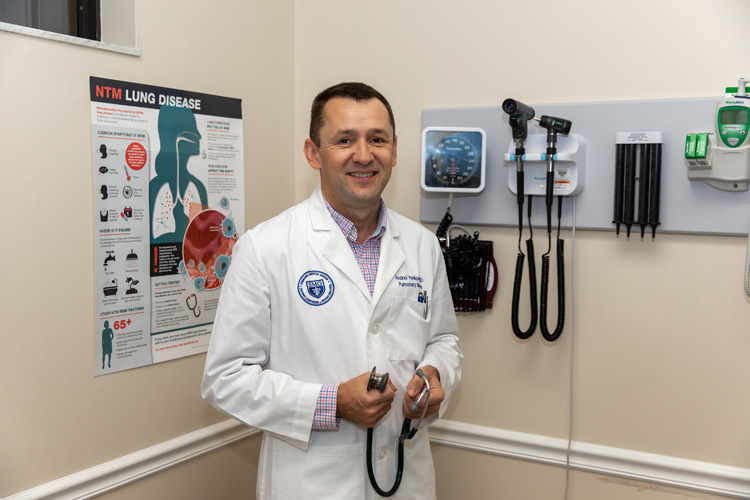
One of the most talked about – yet least understood – emergency lung problems in the U.S. today seems to be directly tied to something that didn’t even exist just 20 years ago.
Vaping.
Dr. Andrei Yankovich, a pulmonologist at Riverside Pulmonary and Internal Medicine and Steward Health Care in Sebastian, knows more about the impact of vaping than most any layperson but even he admits that no one can identify with certainty the precise cause of the current crisis.
What crisis?
According to the New York Times, the Centers for Disease Control and a range of state health agencies reported more than 2,600 vaping-related lung injury cases in August 2019 that were so severe they required hospitalization.
Of those 2,600-plus cases in a single month, at least 59 resulted in death.
Figuring out why vaping is killing people is complicated, in part because there are so many chemicals involved and because vaping products are produced via unregulated manufacturing processes.
Vaping involves using a device – usually called an e-cigarette or vape pen – that electronically heats up a small amount of liquid, turning it into a vapor that can be inhaled. Most vaping liquids are sold in cartridges, pods or custom containers with propylene glycol and glycerol, as well as assorted flavor additives that create the vapor to be inhaled.
THC and other drugs are included in the vapor-producing liquid in some cases.
Yale Medicine says the mysterious lung illnesses the CDC is investigating have been dubbed “EVALI,” an acronym for “e-cigarette or vaping product use-associated lung injury.” Most of these severe and sometimes-fatal lung infections have occurred in otherwise healthy individuals.
“As more details emerged, doctors and researchers discovered that all these patients shared at least one common risk: All reported they had recently used e-cigarette or vaping products,” according to Yale Medicine.
The irony here is that vaping products were initially promoted as a “healthier way” for cigarette smokers to get the nicotine they craved.
Yankovich knows that story well. “I still have patients,” he says with just a hint of an accent from his native Belarus, “who come in and say, ‘Oh, I’m trying to quit smoking. That’s why I’m doing vapes.’ But I am trying to convince them not to do that.”
What sparks an angrier reaction from Yankovich is a New England Journal of Medicine article from October 2019 that reports 20 percent of high school students have tried vaping, often using products with fruit- or bubble gum-flavored liquids.
Flavored vaping liquid was recently banned by the FDA, but black-market manufacturers continue to produce the products.
Meanwhile e-cigarettes aren’t just used as a nicotine or fruit-flavor delivery system anymore.
Instead, they have become a popular delivery system for THC, the psychoactive component of the marijuana plant.
The CDC reports that 82 percent of the lung patients hospitalized after vaping reported using THC-containing products.
That number makes it seem as if THC is the chief culprit in the outbreak of lung infections, but Yankovich says there is much that’s still unknown about the cause of the crisis.
“It could be related to cannabinoids,” he says, but quickly adds “it could be related to nicotine. It could be also related to some of the oils used as additives [in vaping compounds], including vitamin E acetate.”
Vitamin E acetate, a substance commonly found in topical skin care products, showed up in the lungs of 94 percent of EVALI patients surveyed in the CDC’s investigation, and Yankovich says the substance is “the leading candidate, in my opinion, but it’s really hard to say exactly what the cause is now.”
The CDC says the most recent laboratory data show that vitamin E acetate is “closely associated” with EVALI.
But, as of now, the CDC cannot say it is the actual root cause of these pulmonary emergencies and deaths.
That’s in no small part because about 80 percent of vaping product users report buying their supplies from what the CDC calls “informal sources” – meaning friends, street dealers or by going online instead of going through licensed dispensaries.
Indeed, only 16 percent of patients with these lung infections reported acquiring their vaping products exclusively from commercial sources such as recreational and/or medical dispensaries or vape or smoke shops and stores.
If you vape – or ever have – and start to experience any kind of breathing problems, consult your primary care physician or a pulmonologist like Yankovich immediately.
That could save you a trip to the Emergency Room, and possibly save your life.
Dr. Andrei Yankovich is with Riverside Pulmonary and Internal Medicine and the Steward Health Group. His offices are at 12920 U.S. 1, Suite A in Sebastian where the phone number is 772-388-8322.



